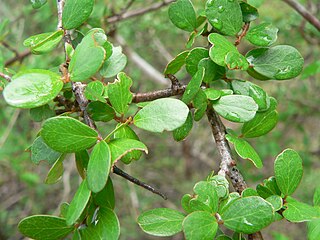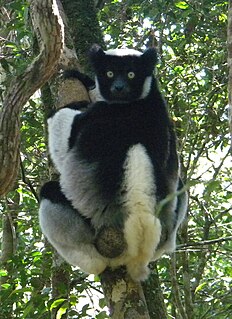
The Madagascar lowland forests or Madagascar humid forests are a tropical moist broadleaf forest ecoregion found on the eastern coast of the island of Madagascar, home to a plant and animal mix that is 80 to 90% endemic, with the forests of the eastern plain being a particularly important location of this endemism. They are included in the Global 200 list of outstanding ecoregions.
Kaliphora madagascarensis is a species of evergreen shrub or small tree. It is endemic to Madagascar, where it inhabits subhumid woodlands and forests in eastern Madagascar, in the provinces of Antananarivo, Antsiranana, Fianarantsoa, and Mahajanga.

Masoala National Park, in northeast Madagascar, is the largest of the island's protected areas. Most of the park is situated in Sava Region and a part in Analanjirofo. Created in 1997, the park protects 2,300 square kilometres of rainforest and 100 square kilometres of marine parks. The Masoala Peninsula is exceptionally diverse due to its large size, and variety of habitats. Altogether, the park protects tropical rainforest, coastal forest, flooded forest, marsh, and mangrove. Three marine parks protect coral reefs and a dazzling array of marine life.
Andasibe-Mantadia National Park is a 155 square kilometre protected area, located about 150 km east of Antananarivo, consisting principally of primary growth forest in Alaotra-Mangoro Region in eastern Madagascar. The park's elevation ranges from 800 to 1260 meters, with a humid climate. Average annual precipitation is 1700 mm, with rainfall on 210 days of each year. This rainforest is habitat to a vast species biodiversity, including many endemic rare species and endangered species, including 11 lemur species. The park's two component parts are Mantadia National Park and Analamazoatra Reserve, which is best known for its population of Madagascar's largest lemur, the indri.
Lemurophoenix halleuxii is a species of palm tree, the only species in the genus Lemurophoenix. It is found only in Madagascar. It is threatened by habitat loss and overcollection. There are perhaps 300 mature individuals remaining in the wild.
Asteropeia mcphersonii, a species of plant in the Asteropeiaceae family, is a shrub to large tree, up to 25 meters tall. Its oval leaves are about twice as long as they are wide and have a leathery texture. It is endemic to Madagascar, distributed in mid-elevation forest in a narrow band from Ambatovy to Zahamena RNI. Its natural habitat is subtropical or tropical moist lowland forests. It is threatened by habitat loss, with an estimated total population of 1000–2,500 mature individuals.

Khaya madagascariensis is a species of plant in the family Meliaceae. It is found in Comoros and Madagascar.
Melanophylla alnifolia is a species of plant in the Torricelliaceae family. It is endemic to eastern Madagascar. Its natural habitat is tropical moist lowland and montane forests. It is threatened by habitat loss.

Zahamena National Park is a national park of Madagascar. Established in 1997, it covers an area of 423 square kilometres (163.32 sq mi) out of a total protected area of 643 square kilometres (248.26 sq mi). It is part of a UNESCO World Heritage Site, Rainforests of the Atsinanana, inscribed in 2007 and consisting of 13 specific areas located within eight national parks in the eastern part of Madagascar. In 2001, Bird Life International assessed avifauna of 112 species of which 67 species are exclusively endemic to Madagascar.

Calumma brevicorne, the short-horned chameleon, is a species of chameleon endemic to Madagascar.
Rhodolaena acutifolia is a plant in the family Sarcolaenaceae. It is endemic to Madagascar. The specific epithet acutifolia is from the Latin meaning "sharp-leafed".
Rhodolaena humblotii is a plant in the family Sarcolaenaceae. It is endemic to Madagascar.
Eremolaena humblotiana is a plant in the family Sarcolaenaceae. The species is endemic to Madagascar. It is named for the French naturalist Léon Humblot.
Schizolaena pectinata is a tree in the family Sarcolaenaceae. It is endemic to Madagascar.
Canarium elegans is a species of tree in the family Burseraceae. It is native to Madagascar.
Coffea abbayesii is an endangered species of flowering plant in the family Rubiaceae. It is endemic to Madagascar. It was described by Jean-François Leroy in 1961.
Humbertiodendron is a monotypic genus of flowering plants belonging to the family Trigoniaceae. The only species is Humbertiodendron saboureaui.
Ephippiandra madagascariensis is a species of flowering plant endemic to Madagascar, where it is known as ambora.
Ephippiandra perrieri is a species of flowering plant endemic to the Northern Highlands of Madagascar.
Ephippiandra tsaratanensis is a species of flowering plant endemic to the Tsaratanana Massif of northern Madagascar.





